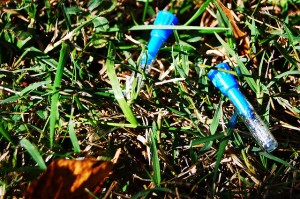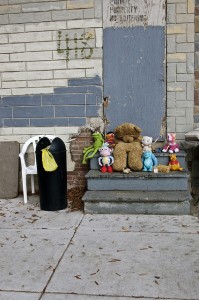This was originally published 8/23/2011. More should have changed by now. This is a sort of permanent redux. Today is my birthday, a good time to reflect. And one of the things I have found myself brooding over lately is my love of Baltimore. As fans of The Wire know, the city has more than its fair share of problems — drugs, violence, and HIV, to name a few. I moved to Baltimore in 2006. And I spent a healthy chunk of the nine months I lived there trying to understand why those problems exist. Specifically, I wanted to understand why Baltimore became a hotbed for heroin and how the city’s heroin addiction fueled the spread of HIV. I interviewed dozens of people and tried to make sense of what they told me. The end result was my graduate thesis.
Today is my birthday, a good time to reflect. And one of the things I have found myself brooding over lately is my love of Baltimore. As fans of The Wire know, the city has more than its fair share of problems — drugs, violence, and HIV, to name a few. I moved to Baltimore in 2006. And I spent a healthy chunk of the nine months I lived there trying to understand why those problems exist. Specifically, I wanted to understand why Baltimore became a hotbed for heroin and how the city’s heroin addiction fueled the spread of HIV. I interviewed dozens of people and tried to make sense of what they told me. The end result was my graduate thesis.
The following piece is a chapter from that document. I’ve changed the name of the main character to protect his privacy, and I’ve shortened it a bit to make it more blog-friendly (though it’s still a long read).
Readers of LWON, meet Leroy.
Leroy Wallace, standing in the lobby of the Baltimore’s Moore Clinic, is bird thin beneath his dark jeans and cream sweater. A gold cross, suspended from a fragile chain, hangs halfway down his chest. He introduces himself, shakes my hand, and we follow a nurse to a quiet room where we can talk. Leroy is eager and his false teeth, one of which is gold, clack rhythmically as he tells me the story of how he became a heroin addict.
Leroy, who was born in 1950, grew up on the east side in a two-story rowhouse. His mother, just 16 when she had Leroy, worked as a laundress for Johns Hopkins. Leroy’s father, an alcoholic, was in prison more often than he was out. Money was tight and, by the time Leroy was 15, he was already doing odd jobs—delivering papers, collecting bottles, shoveling snow. “That’s how I made my ends meet,” he recalls.
After graduating from high school, Leroy joined the military. He ended up in Vietnam. “That’s when I got the drug addiction,” says Leroy. He was not alone. US medical officials estimate that by 1971, 10% to 15% of the low-ranking enlisted men serving in Vietnam were hooked on heroin. Leroy was dishonorably discharged in 1973 and came back to Baltimore, bringing his addiction with him.

In Vietnam, Leroy had only snorted heroin. When he got home, his brother-in-law showed him how to inject it. The high was a “whole hell of a lot better,” he says. But the process made Leroy squeamish; he couldn’t put a needle in his own arm. So he would give a little dope to whoever was willing to find his vein while he looked the other way. “All them years using,” Leroy says shaking his head, “and I’m scared to death of needles.” Sometimes Leroy would visit shooting galleries, where sharing needles was standard practice. An addict would get his fix and then pass his cooker and syringe off to another addict.
During the day, Leroy worked at the Department of Social Services, pushing paper. At night, he worked as a stick-up boy, relieving dealers of their dope with the help of a shotgun. “From eight to four I was a professional, and after four o’clock I was a hood again,” he says. Leroy remembers trying to rob a place rumored to be a stash house for marijuana. “We thought there was nobody there but the guy and his old lady,” says Leroy, his eyes twinkling. “But when we busted in the door, they had a party going on in there. Everybody else in that party got stuck up for being there.”
Eventually Leroy’s luck ran out. In 1976 he was charged with welfare fraud and spent 90 days in jail and a few weeks in rehab. But the addiction counseling didn’t take. He started using again and just six months later he was arrested for armed robbery. Since Leroy was holding the shotgun, he got a ten-year sentence. While he was in prison, his wife, with whom he had a daughter, filed for divorce and his father died of a drug overdose.
Leroy was released after serving only six years. A few months later he was back in the drug game, working as a courier. He picked up packages, brought them to be cut and bagged, and delivered the bags to the street dealers. He hadn’t been using in prison, but once he was out, he started again. By the mid-80s he was back in prison, serving a two-year sentence for possession.
When Leroy got out, he went back to shooting dope. One day his uncle, also a heroin addict, told Leroy that he couldn’t use his tools anymore. “I didn’t pay it no mind.” Leroy remembers. “But he passed away six months later. Come to find out it was because he had AIDS.”
Leroy first got tested in 1988. He found out Hopkins researchers were offering heroin users $10 to take an HIV test. They gave him another $10 when he picked up his results. He tested positive. “When they told me I had the bug,” says Leroy, “it took me about two hours before I left the clinic because I was in a state of shock. The only thing I knew was that people died within six months. There wasn’t no cure for this madness.” By then Leroy was married again, and he was afraid that he might have passed the virus on to his wife. “My greatest fear was how do I tell my wife that she may have contracted this deadly disease,” Leroy says. “My wife did not use drugs; she didn’t smoke; she didn’t do nothing but work.”

His wife tested negative, but she and her daughters wanted less and less to do with Leroy. The word on the street was that even the most benign contact was dangerous. “They were saying you could get it from saliva,” he recalls, “or drinking out of the same glass.” Leroy checked into the VA Hospital, where the staff put him in a room by himself. They made him eat off paper plates with plastic utensils. When they came in to bring him food or take blood, they wore long gowns, gloves, and masks. “They alienated me,” says Leroy. Eventually he was discharged; it didn’t take him long to find his way back into the drug scene.
All through the ‘90s Leroy continued to shoot dope, but he also developed a taste for cocaine. “I’ll never forget that high,” Leroy tells me, smiling beatifically. “It gave me a rush. I heard bells. Beautiful high.”
Today Leroy is clean. Six years ago he found his way to the Moore Clinic, an AIDS clinic at Johns Hopkins. His doctor recommended drug treatment and sent him to a treatment facility in East Baltimore, where he receives counseling, education, group therapy, and a daily dose of liquid methadone, a substitute for the heroin that he no longer uses. He met his third wife there. “I got lucky to find me a woman,” says Leroy. “Life’s been good for me.”
All things considered, Leroy looks healthy. But his CD4 count, the number of CD4 cells circulating in his blood, is dangerously low. CD4 cells are immune cells that send out chemical messages that ramp up the entire immune system. A healthy person has a CD4 count between 500 and 1500. A count less than 200 in an HIV-infected person is defined as AIDS. Leroy’s count hovers around 60. His immune system is so damaged that even the mildest infections can cause serious illness.
Leroy has been on medication for years. The meds are supposed to stop the virus from replicating and killing CD4 cells. But when Leroy was using, he would often forget to take them. As a result, the virus became resistant and his meds stopped working. “I went through damn near every regimen they had,” says Leroy. Now the virus he carries is resistant to almost every combination of drugs available. Leroy admits he’s still not taking his medications the way he should be. He doesn’t think his good health is due to the anti-viral pills. “I just haven’t reached my destiny yet,” Leroy explains. “My higher power is keeping me here.”
For Leroy, HIV has been a godsend. By the time he made his way to the Moore Clinic, he’d already overdosed several times. His fellow addicts at the shooting gallery would drag him into the street so that they wouldn’t have to deal with police. If it hadn’t been for the virus, Leroy would never have gotten clean. “I’d be dead right now, I know I would be,” he says. In a way, Leroy believes that HIV saved his life. “It’s crazy to thank God for HIV,” he says, but that doesn’t stop him.
Leroy passed away last fall. The Hopkins nurse who introduced us sent me the following message: “His energy and love of all in our Hopkins HIV community and in the Baltimore addiction recovery community was a big love. He is missed so much. He had the greatest energy and was a loving and caring man. [Leroy] was so open about his diagnosis and supported so many others to live fully with their own HIV infection.”
Goodbye, Leroy. And Godspeed.
—
“Drugs” image courtesy of gavin heck on flickr
Photo of discarded vials courtesy of sidewalk flying on flickr
Image of a child’s memorial courtesy of DrJohn 2005 on flickr
And where was your graduate advisor when you were traipsing around with addicts and shotguns and prisoners and people with HIV? Where?
I’m sorry to hear Leroy died. He surely had gifts he didn’t have time to use.
She probably didn’t tell you what she was doing and didn’t leave enough clues for you to ask. And yes, a death like Leroy’s is hard, hard, hard.